
Arriving in Atrani
By bus from Napoli to Atrani
I took a bus from Napoli, down the coast and out
along the coast of the Peninsola Sorrentina,
through Sorrento on its northern coast and around
to Amalfi on the southern coast.
From there it was a short walk to where I stayed in Atrani,
right next to Amalfi but with a much nicer atmosphere.
See the below map of the Italian coast around the
Golfo di Napoli,
with the Peninsola Sorrentina extending out
into the Tyrrhenian Sea to its south.
The town of Amalfi is on the south coast of
that peninsula.
The slightly smaller town of Atrani lies just
to its east, a short walk of ten minutes that takes you to a
very different and much nicer and more authentic atmosphere.
This is rugged territory, notice the closely spaced contour
lines and the high peaks (marked in feet,
this is a U.S. military chart) close to the shore.
Also notice how close the 100-fathom line is to the shoreline
in places.
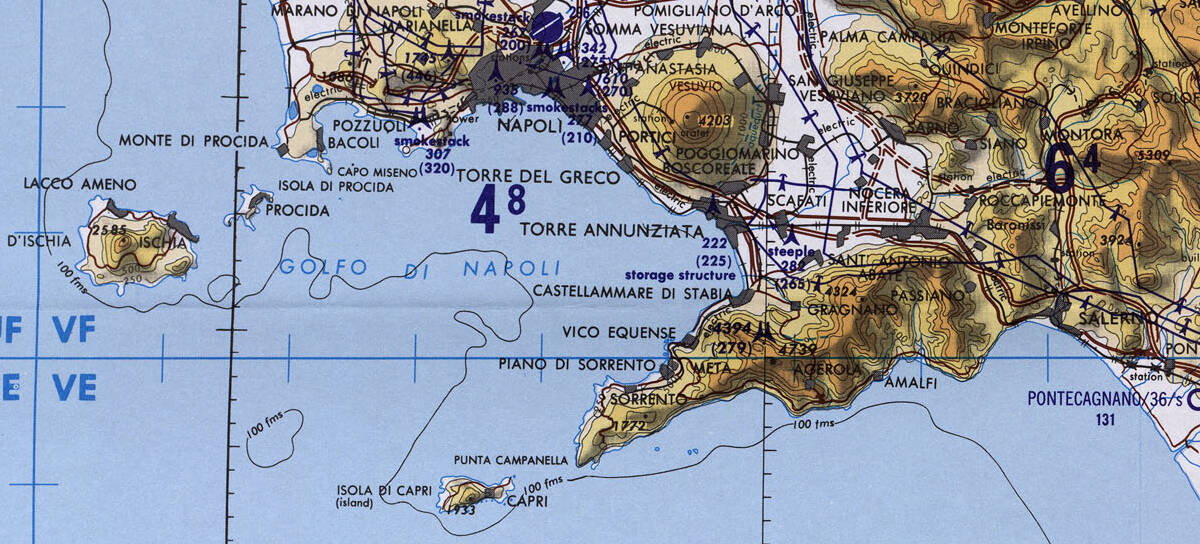
Portion of aeronautical chart F-2C, from the Perry-Castañeda Library Map Collection at the University of Texas at Austin.
See the island off the tip of the peninsula? The island is pronounced KAH-pree, while kah-PREE is a type of trousers. Now you can speak of it as if you were a member of the cognescenti, to use yet another Italian word.
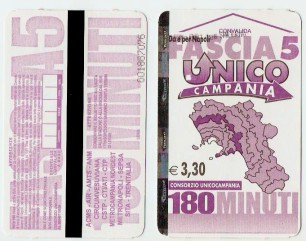
Bus ticket from my 2007 visit.
I bought a bus ticket in Napoli, the capitol of the Campania region. The bus ticket was good for a ride from Napoli to a belt of locations shown in darker purple and taking up to 180 minutes to reach, including parts of the Amalfitani coast.
The bus from Napoli went down the coast below the volcano Vesuvio, then wound slowly along the north shore of the peninsula, across its tip, then back east along the south shore.
The ride to Amalfi took just about an hour and 45 minutes, southeast from Napoli along the coast, west out the north shore of the peninsula and through Sorrento, then crossing to the southern coast and east to Amalfi.
Here is the view from out on Amalfi's pier, as if I had arrived by boat. The coast road passes through Amalfi just above the beach and just in front of those buildings.

I was going to Atrani. If I been there before, I would have known that I could stay on the bus and ask to get off at the next stop. But Atrani is just ten minutes' walk from Amalfi.
I knew that much of the Amalfitani coast was almost entirely dedicated to tourism, with constant buses and boats filled with people in each place for just an hour or two before moving on.
I wasn't sure, but I had the idea from guidebooks that Atrani might be a little less touristic, a place where the local employees of the tourism operations lived. That turned out to be correct — Atrani had, by far, the nicest atmosphere of anywhere I saw along the Amalfi coast.
Amalfi has a population of about 4,600 people and constant arrivals of buses and tour boats. Atrani has a population of just 830.
Below is a view looking across the beach of Amalfi from the pier. The coast road continues east over that row of arches and then up and around that point. I needed to walk along the coast road and around that point, where a small fortified tower had been converted into a small restaurant.
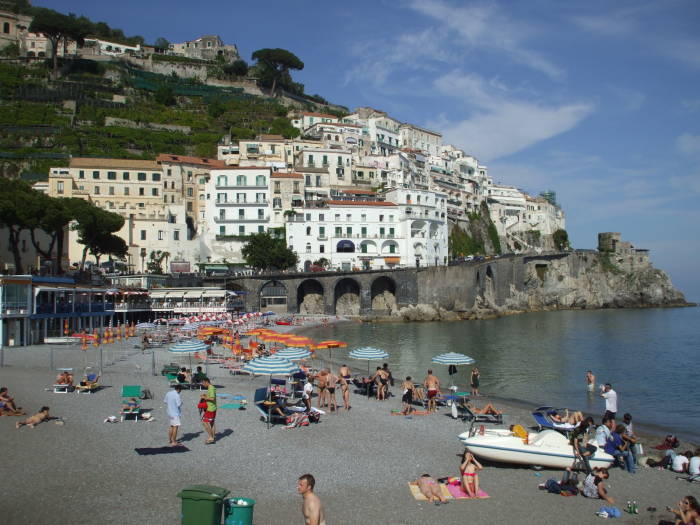
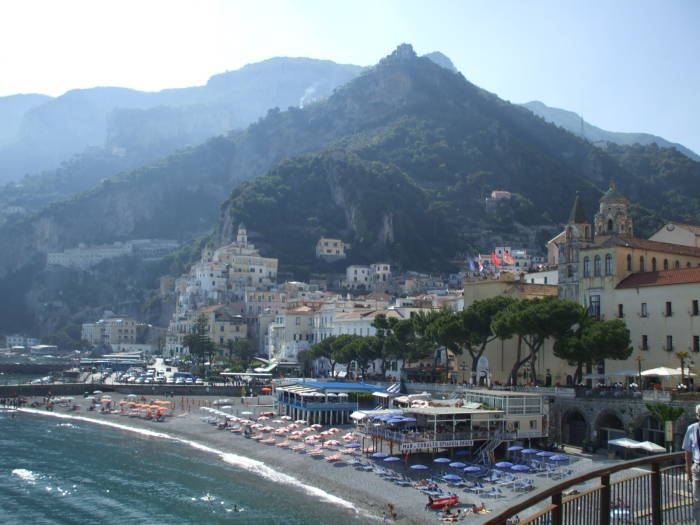
Above is the view back to Amalfi as I was about to go around that point.
Walking from Amalfi to Atrani
The blue bus is one of those running each direction between Salerno and Sorrento every hour or so. As you can see, the coast road is rather narrow. And this is one of the wider sections!

The movie Beat The Devil was set here, with some scenes featuring the coast road. It starred Humphrey Bogart, Gina Lollobrigida, Robert Morley, Peter Lorre, and many other prominent actors. It was directed by John Huston and co-written by Huston and Truman Capote. They are said to have done the writing in daily installments as it was being filmed.
Huston intended it to be a spoof of his The Maltese Falcon in particular and film noir in general. It has to do with the misadventures of a group of swindlers trying to lay claim to a block of uranium deposits in Kenya while they wait for a tramp steamer to take them from Italy to Mombasa. It has been misunderstood or at least mislabeled as a variety of genres including "thriller", "drama," "crime" and "romance", and it would be a rather poor representative of any of them.
Bogart disliked the movie, maybe because he lost a lot of his own money funding it. Its copyright was not renewed, so now it is in the public domain.
The coast road passes through a short tunnel. A restaurant with a green roof is built on a ledge on the cliff outside that tunnel. But if you look closely here, you can see how things have changed since the days of Bogart.
The tunnel is relatively new, and the road used to go down a steel slope where that restaurant is now built. The road then split, roughly along the lines of the two blue railings. The upper branch continued as the coast road, while the lower branch led down to the beach and into the town of Atrani.
Of course, I had not yet figured this out because I was just then arriving for the first time....

I could better see the restaurant on that narrow ledge as I approached the tunnel.
The coast road continues straight ahead through the tunnel, and the entrance to the Zaccaria restaurant was just to the right of the tunnel entrance.

I had read that you could simply get off the bus in Amalfi and walk over to Atrani, but there had been no mention of walking through a one-lane tunnel with no sidewalk. There seemed to be no alternative, so on my first arrival I hurried through that tunnel.

What you are supposed to do is to walk through the Zaccaria restaurant and out its back door. Simply walk right through it, as seen below.
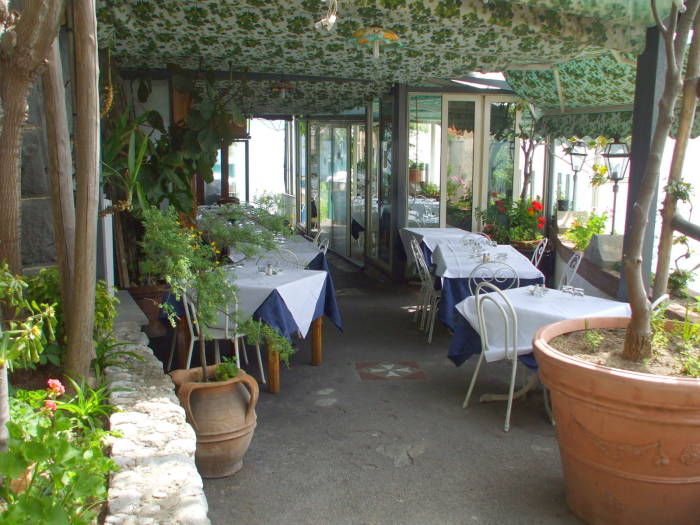
Yes, it's a restaurant, but there is a public right of way through it. Go ahead, walk through, everyone does because the restaurant has put its tables on the sidewalk between Atrani and Amalfi. When you get to the door to the kitchen at the back end of the restaurant, just step out through the back door. Then walk down the steps and continue along the road.
If you are going to Atrani, go down to the right toward the waterfront. If you went to the left, it would lead you back up to the coast road at the other end of the tunnel
You will come around the corner and see Atrani ahead of you, as seen below.
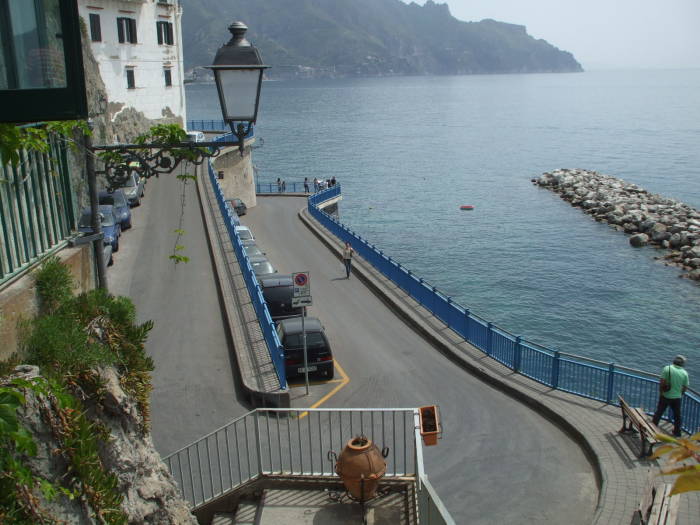
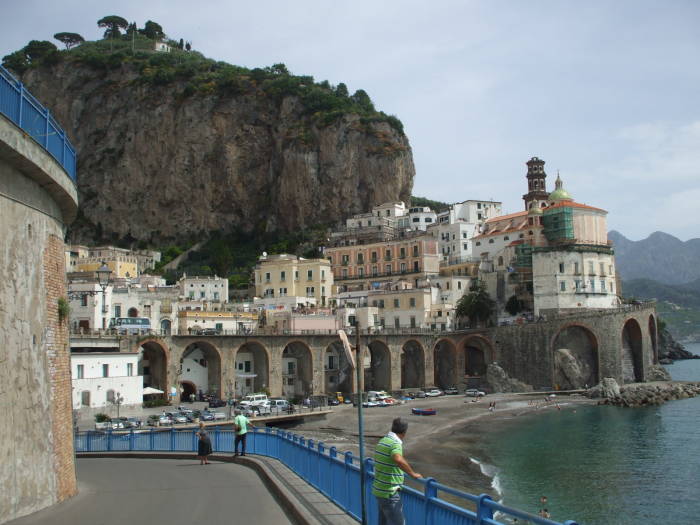
At this point I was very happy with the results of having done Pimsleur's Italian I course. I was able to ask a guy, "Dove è Piazza Umberto?", and then handle his response and thank him politely.
I had to go down the stairs from the coast road to the beach, because I had walked through the tunnel and I was still up on the coast road. But when you get down to the beach area, you can go through a small tunnel, visible here in the second arch supporting the coast road. That tunnel leads to Piazza Umberto.
No, I didn't get all of that verbatim and literally, but I got the gist of it.
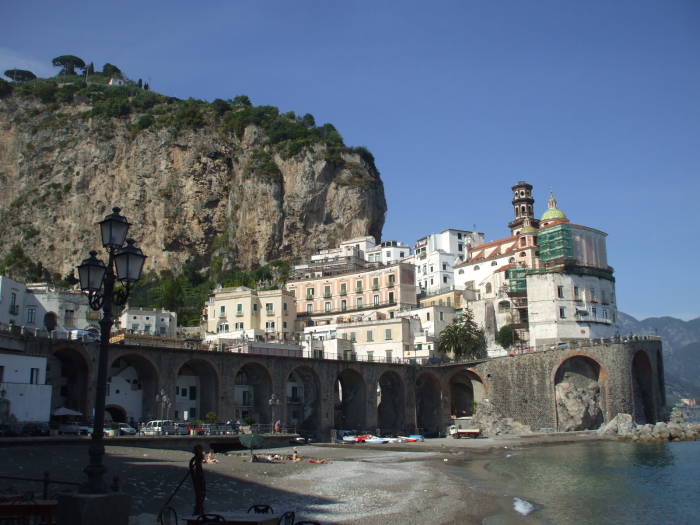
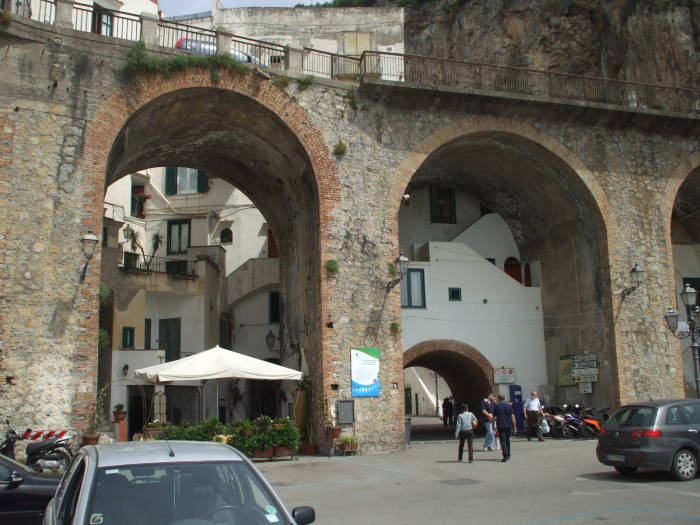
The coast road passes through Atrani on a series of stone arches over ten meters above ground level. The first three stories of the buildings are visible through those arches, and smaller archways pass through those buildings and into the town.
The largest of those archways passes under the road, through the buildings, and into Piazza Umberto, the main square of Atrani.
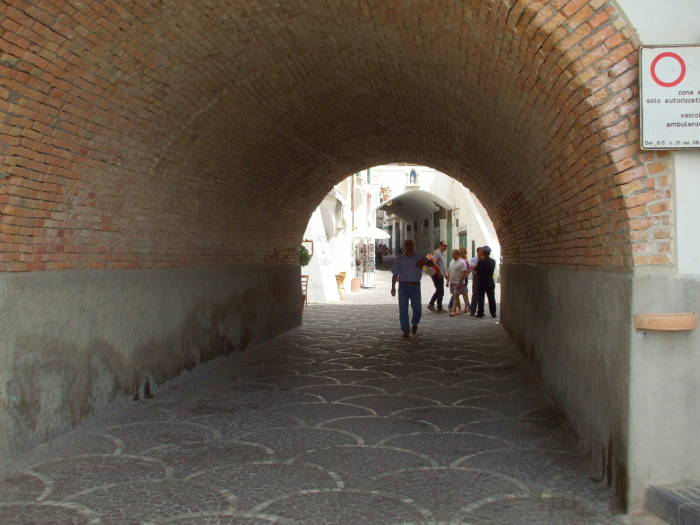
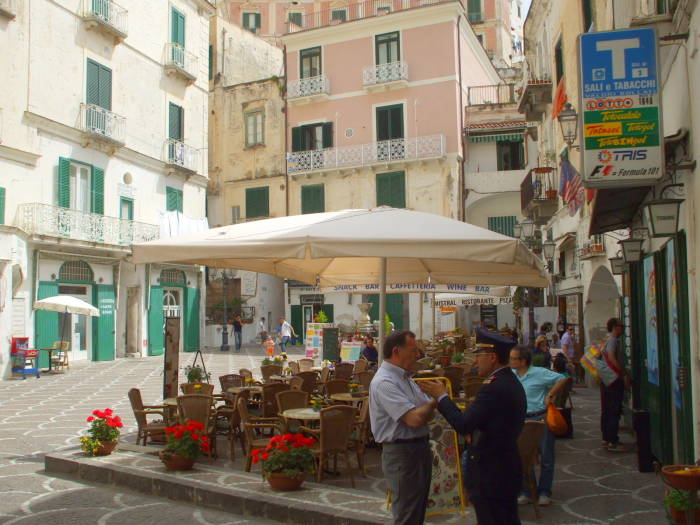

There are some sidewalk cafes, and there is a minor official in an elaborate uniform. Yes, we're still in Italy.
See the white-on-blue "T" sign for a tabacchi, a shop where you can buy things like bus tickets. A tabacchi is to Italy as a tabac is to France.
I was looking for Hostel a'Scalinatella, whose name literally means "Of (or at) the Little Staircases". A sign at one of those green doors across the piazza directed me further up the street.
Continuing across the piazza, here's a look back at those cafes. I would be back there many times.

The directions to a'Scalinatella led me on back into Atrani along the only vehicular passage and through another arch.
Once through this arch I would continue up the right side of the lane ahead and then go into a narrow parallel passageway.
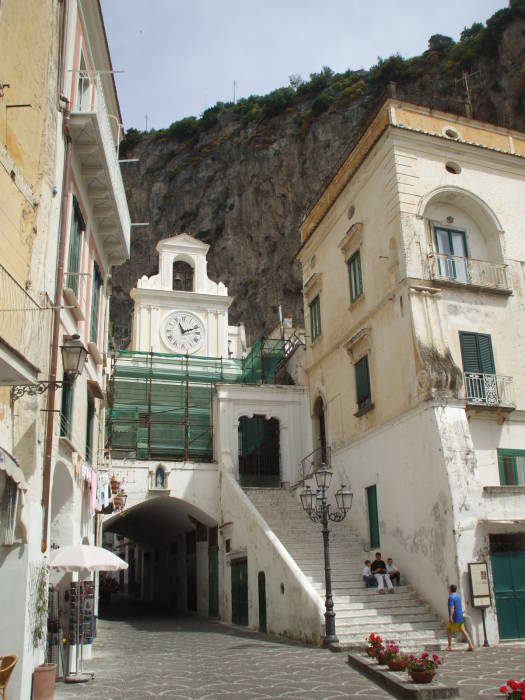
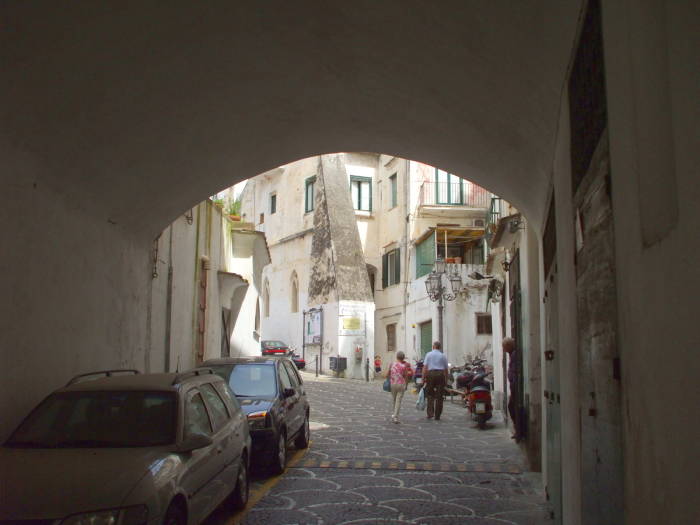
Here is that passageway. Many of the back "streets" of Atrani and other Amalfi Coast towns are narrow passageways like this, some of them completely enclosed and passing through buildings.
Turn to the right at the end of that dark tunnel and go up a short flight of stairs The staircases branch — turn to the right and go up that narrow curving little staircase.
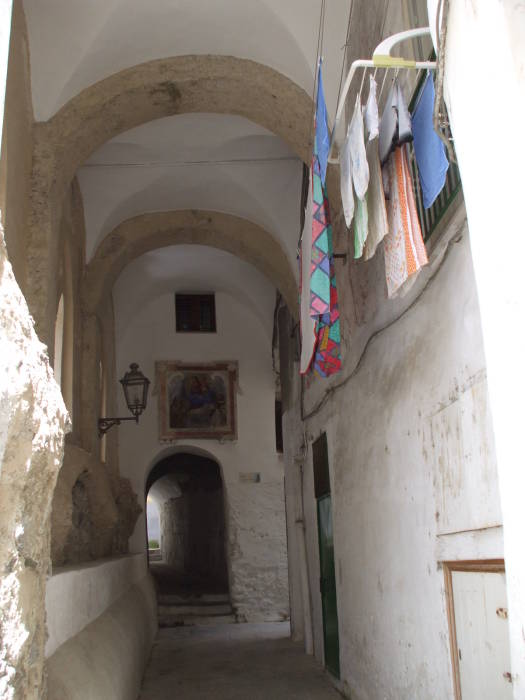
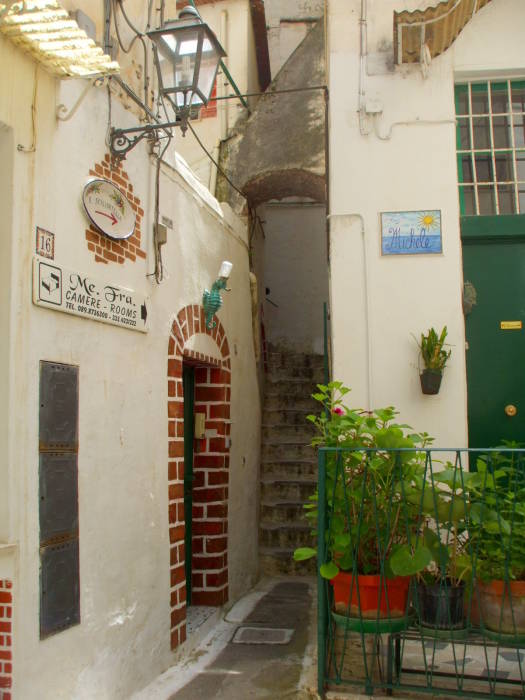
Yes, a'Scalinatella seems to be a very appropriate name!
Hostel a'Scalinatella was a great place to stay! Filippo, the manager, really made me feel at home. The rooms are cool, dark, quiet, and restful, because they are partially tunneled back into the cliff faces.
I got settled in, then went back to Piazza Umberto for a great lunch at one of the cafes. Then I walked back to Amalfi for some tourism.
Next❯ The sights in Amalfi and Atrani
Where Next In Italy?
( 🚧 = under construction )
In the late 1990s into the early 2000s I worked on a project to
scan cuneiform tablets
to archive and share 3-D data sets,
providing enhanced visualization to assist reading them.
Localized histogram equalization
to emphasize small-scale 3-D shapes in range maps, and so on.
I worked on the project with Gordon Young,
who was Purdue University's only professor
of archaeology.
Gordon was really smart,
he could read both Sumerian and Akkadian,
and at least some of other ancient languages
written in the cuneiform script.
He told me to go to Italy,
"The further south, the better."
Gordon was right.
Yes, you will very likely arrive in Rome,
but Italy has domestic flights and a fantastic train system
that runs overnight sleepers all the way to
Palermo and Siracusa, near the western and southern corners
of Sicily.
So, these pages are grouped into a south-first order,
as they should be.
